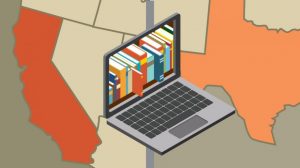The Hottest Stories in the Ed. Market in 2018, and What It Means for the New Year
What EdWeek Market Brief stories drove the conversation within K-12 companies in 2018? Our readers were hungry for details about the cutting-edge ed-tech tools in the K-12 marketplace, the kinds of products that educators are most clamoring for, and business strategy focused on the school sales cycle.
The 10 most widely read articles of 2018 delved into those topics. In many cases, they may offer a hint of companies’ priorities over the coming year. All of these stories were premium articles, meaning that their content in its entirety is only available to our members. If you’re not a member, consider becoming one to get the full benefit of our exclusive data, insight and interviews.
Here are the most-read articles of the year:
#1–10 Products that Cut Through the Noise at ISTE, and What It Means for Vendors
At ISTE 2018–the largest ed-tech conference in the country–hundreds of ed-tech products were on display in front of the 24,000 educators who attended.  Three veterans of the ed-tech world highlighted the products that impressed them the most. Some of the products were created by startup companies, like a mashup between a paper airplane and a drone, offered by PowerUp. Others were created by more familiar companies like Lego Education. The educators at ISTE also praised products that focused on fast-growing interests in K-12, such as coding and virtual reality. Read the story for the full list.
Three veterans of the ed-tech world highlighted the products that impressed them the most. Some of the products were created by startup companies, like a mashup between a paper airplane and a drone, offered by PowerUp. Others were created by more familiar companies like Lego Education. The educators at ISTE also praised products that focused on fast-growing interests in K-12, such as coding and virtual reality. Read the story for the full list.
#2–Demand for Social-Emotional Learning Products is High and Expected to Grow
The social-emotional learning product market will continue to pick up speed in 2019, according to an EdWeek Market Brief survey of K-12 administrators. Districts are hungry for curricula that introduce these concepts and can either be used as a stand-alone topic or woven within different academic courses. The survey results showed that nearly all educators said they had either bought social-emotional learning products or expected to do so. But demand was higher from districts in some areas of the country than others.
#3–What Are the Ed-Tech Products that K-12 Educators Wish They Had?
In this exclusive survey of educators, we asked them what their dream digital products were. The answers centered on better data tools and providing students with more access to devices, either with hardware or improved technology infrastructure. A lot of educators wanted to push the envelop with more virtual reality products. Check out the story to see the full wish list from teachers and administrators, and see where your product fits in.
#4—Chinese Companies Making Moves in U.S. Education Market
This in-depth look at the Chinese companies making waves in the U.S. education market is an important read for any American education business. Big Chinese companies like NetDragon are buying up more-established U.S. brands, while others, like tutoring giant TAL Education are investing in American ed-tech startups. The story also dives into the opportunities for U.S. companies and their content in China, where there’s appreciation for American “brands” in education and where a growing middle class is hungry for high-quality content, particularly around English-language instruction.
#5–Where Is ESSA Showing Up in RFPs, Bids and Other Leads? Our Exclusive Analysis Takes a Look
The federal Every Student Succeeds Act has had an influence on purchasing in K-12 districts. In this story we analyzed district RFPs to find out how the law is influencing state and district buying. We found that ESSA language surfaced often in areas ranging from curriculum and assessment to professional development and to special education purchases. Savvy education companies used this exclusive information to position their products and make them more attractive to K-12 district buyers.
 #6—Shifts in California, Texas Markets Create New Dynamics for K-12 Companies
#6—Shifts in California, Texas Markets Create New Dynamics for K-12 Companies
California and Texas are two of the nation’s most important and influential curriculum markets, and decisions made there about products have an impact elsewhere. This deep-dive into the K-12 landscapes of those states found that local districts have increasing autonomy in purchasing classroom materials, but that they still rely heavily on lists of state-approved products. A rising demand for a hybrid of print and digital products was noteworthy and districts were seeking increased customization.
#7–What Types of Professional Development do K-12 Leaders Want for Their Educators?
A lot of school districts lean toward creating and implementing their own professional development programs instead of purchasing from education companies. But vendors that align their offerings with district needs are more likely to find their professional development niche. In this survey, 500 district leaders were asked to rate eight characteristics of professional development programs, revealing what they believe is most effective and in-demand.
#8–Steps for Mastering the Four Season of the K-12 Education Market 
Vendors often complain that the K-12 sales arena is difficult to navigate. But the sales cycle has a rhythm to it and companies need to understand the seasonality of the way schools and districts work. That understanding can help companies determine everything from what time of year it’s best to launch a product, to when to market heavily or do the hard sell. This primer helps companies create a seasonal to-do list that allows them to implement strategic and tactical planning ahead of time to reap significant benefits later.
#9–Schools’ Preference for Print Curricula Remains Strong
We write a lot about ed-tech products and digital tools. But it’s important to keep in mind that the demand from schools and districts for print products is still high. In fact, in these survey results, 67 percent of school leaders said more than half of their curricular materials are print. It’s an important lesson for education companies to keep in mind. However, our survey also revealed that these preferences shift depending on the part of the country a district is located in, as well as district size and demographics. For details, check out the story.
#10–CEOs Reveal the Daily Productivity Habits that Drive Them and Their Companies
We asked nine CEOs of prominent education companies like Kahoot! and Houghton Mifflin to share their strategies for staying focused amid competing demands, requests, opportunities, and challenges as they work to grow their businesses in the education space. CEOs described how prioritized goals, successfully managed fast-growing companies, and kept their eye on the big picture.
Those are the top articles from EdWeek Market Brief for 2018, but be sure to check out our top Marketplace K-12 blog posts of 2018, which are free for all readers–not just members.
Follow EdWeek Market Brief on Twitter @EdMarketBrief or connect with us on LinkedIn.
See also:
- Top Post of 2018 Focus on Big Education Companies and Popularity of Digital Tools
- The Hottest Topics in 2017: Homeschoolers, ‘Net Neutrality’, and Fast-Growing Companies
- What Articles Did MarketBrief Readers Like the Most in 2017? Here’s a Look at Our Top 10

Grazie per aver condiviso queste storie informative su Ed. Mercato. È anche un mercato ben scritto riporta perfettamente sul punto. Sono totalmente d’accordo con te. In realtà, sto anche lavorando come digital marketer e blogger. Di recente, ho pubblicato un articolo efficace sulla creazione di un sito Web aziendale qui- https://sitechecker.pro/how-to-create-a-website/ In questo articolo spiego il sito Web SEO perché è anche molto importante classificare qualsiasi sito Web in questo mercato competitivo. Quindi, dovresti conoscere il mercato in cui ottieni più lavoro o opportunità di lavoro.